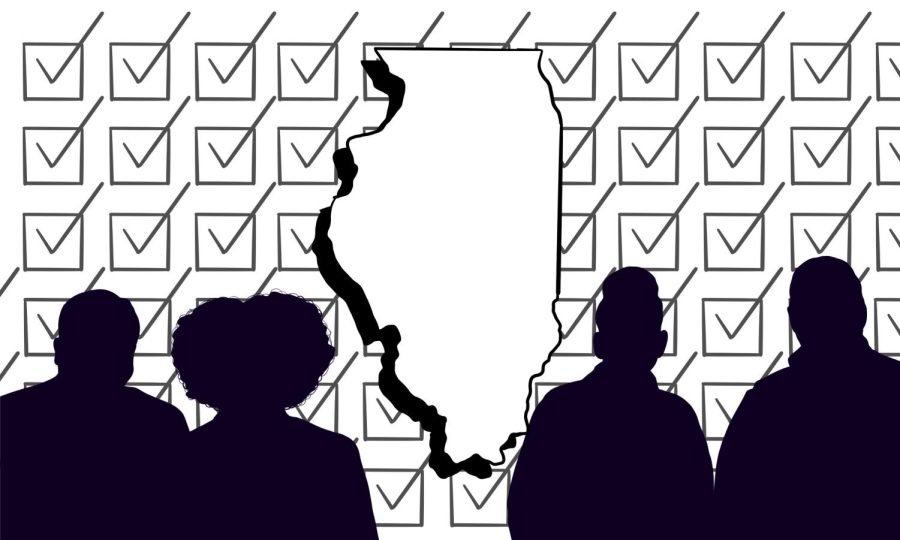The Daily Explains: Ranked-choice voting is up for debate this November. Here’s how it could impact Evanston
File Illustration by Olivia Abeyta
Evanston residents will decide if Evanston should have a ranked-choice voting system on Nov. 8.
October 25, 2022
In just two weeks, Evanston residents will vote not just on local and state representatives — but on the city’s voting system itself.
In July, City Council unanimously approved a referendum for the Nov. 8 general election ballot asking Evanston voters if they want to use ranked-choice voting. Under Evanston’s current “winner-take-all” election system, the candidate with the most votes wins, even if they haven’t earned a majority of votes. Ranked-choice voting ensures candidates have majority support to be elected.
Residents have mobilized to spread awareness about how ranked-choice voting differs from Evanston’s current system, with local initiative RCV for Evanston holding phone banking events and door-knocking campaigns ahead of November.
The initiative is endorsed by a range of local leaders, including Alds. Melissa Wynne (3rd), Jonathan Nieuwsma (4th), Eleanor Revelle (7th) and Juan Geracaris (9th). State Rep. Robyn Gabel (D-Evanston) has also lent her support to the measure.
If passed, the referendum will establish the new system, beginning with the spring 2025 mayoral, city clerk and City Council elections. Ranked-choice voting would eliminate Evanston’s separate primary election for these positions, consolidating the voting process into one general election.
How ranked-choice voting works
In a traditional election, voters cast their ballots for one candidate per position. Under ranked-choice voting, candidates could receive the most votes and still not automatically win if a divided election prevents a majority.
RCV requires voters to select multiple candidates at the polls, ranking them based on preference. Votes are tallied, and if a candidate garners more than 50% of first-choice votes, they win the election — just like normal.
But if no candidate reaches that threshold, the election isn’t over. The candidate with the fewest votes gets eliminated and residents who chose that losing candidate have their votes transferred to their second choice.
After this process, the votes are retallied. The process repeats until a candidate receives more than 50% of the vote.
A nationwide push
If approved, Evanston will join a suite of constituencies across the country that have adopted ranked-choice voting.
Fifty-six cities, counties and states have ranked-choice voting in place, according to electoral reform organization FairVote. The system is used by two states, Alaska and Maine, in statewide and general federal elections.
New York City adopted ranked-choice voting in 2019, first using it in its 2021 elections for mayor, city council and other offices.
Eric Friedman, assistant executive director for public affairs at the New York City Campaign Finance Board, told Evanston City Council in June that about one million people voted in the June 2021 primary election — the highest turnout for a local New York City election in decades.
Evanston’s referendum isn’t the first time Mayor Daniel Biss, who has endorsed RCV for Evanston, has pushed for ranked-choice voting.
As an Illinois state senator, Biss introduced a bill in 2017 that would have set up ranked-choice voting for state elections. The bill died in the state senate in 2019.
Potential impacts
According to RCV for Evanston, ranked-choice voting is a longer electoral process, but ensures that elected officials have majority support.
RCV for Evanston states that ranked-choice voting promotes diversity of political beliefs and backgrounds among candidates, while also discouraging negative campaigning.
Ranked-choice voting advocates also say it ensures residents’ votes remain impactful even if their first-choice candidate loses. This reduces “wasted votes,” according to electoral reform software company RankedVote.
But critics argue that changing the electoral process would decrease voter turnout. While residents know how to fill out a “winner-take-all” style ballot, implementing a new system could create confusion.
At a July City Council meeting, San Francisco State University associate professor Jason McDaniel shared his findings about accessibility in ranked-choice voting. Across seven cities, he found that ranked-choice voting, on average, caused a decrease in voter turnout in the first two elections following its induction.
“More complex voting tasks — how to select more than one candidate or multiple candidates — results in higher ballot errors,” he said.
Alisa Kaplan (Pritzker ‘11, Ph.D. ‘14), Reform for Illinois executive director, told City Council that, to her knowledge, McDaniel is the only scholar who found this turnout decrease. She cited academia finding that ranked-choice voting has increased turnout in constituencies among youth voters and poor communities.
According to Kaplan, ranked-choice voting’s consolidation of primary and general elections would benefit Evanston.
“Ranked-choice voting would eliminate our very-low-turnout primaries, prevent a tiny slice of our electorate from narrowing the choices down for everyone else, and enable many more people to participate in the full electoral process,” Kaplan told City Council.
Email: [email protected]
Twitter: @JorjaSiemons
Related Stories:
— The Daily Explains: What to expect on your ballot this November
— Turnout unclear at Evanston’s upcoming midterm elections
— City Council approves referendum on ranked-choice voting for November ballot
Web correction: A previous version of this article misstated Alisa Kaplan’s Northwestern affiliation. The Daily regrets the error.












